How to Master Change Management in the Restaurant Industry
Find out how to manage change in restaurants by using digital tools, effective communication and team engagement to ensure success and transformation.
How can restaurateurs use ChatGPT to their advantage? What possibilities are there to use the chatbot in restaurants? Read more about it here.
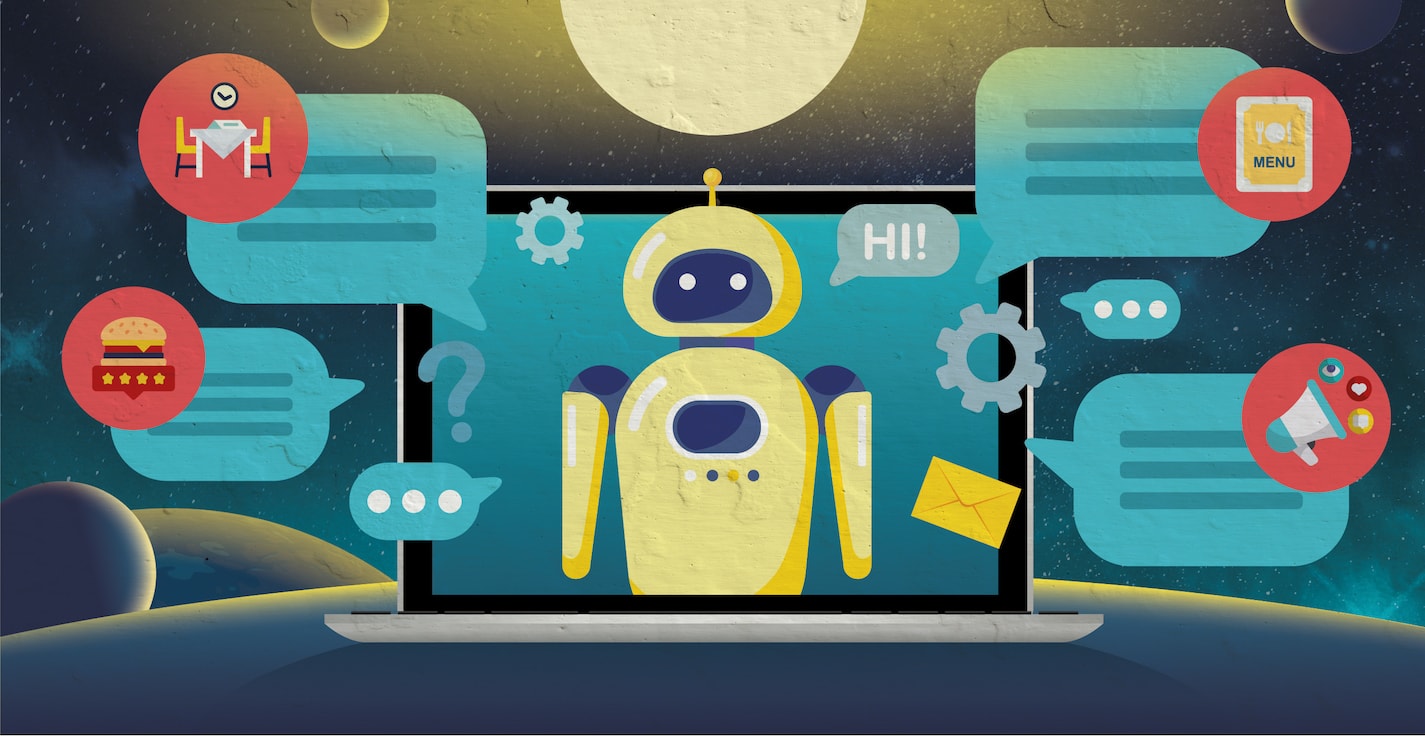
What do you think: How can restaurateurs use ChatGPT for their benefit?
Who better to answer this question than ChatGPT itself. That's why I recently asked the chatbot this very question and requested a paragraph for a blog article. This was the answer:
"Chatbots like ChatGPT are becoming increasingly popular in the restaurant industry. They can automate customer service, streamline operations and enhance customer experiences. From staff scheduling to menu design, there are numerous applications for ChatGPT in the restaurant industry."
Since I intentionally asked for only one paragraph, the answer is very general. Nevertheless, it provides interesting aspects that I want to pick up and look at in this article. Specifically, I address these points:
ChatGPT is a dialog-based chatbot created by the US company OpenAI, which is based on machine learning and artificial intelligence. GPT stands for "Generative Pre-trained Transformer". This means that the chatbot has been trained with an enormous amount of text data. This is how ChatGPT has learned to understand and generate human sentences.
Users "feed" the tool with a sentence or question and the chatbot generates coherent information taken from publicly available datasets.
ChatGPT can be used in a variety of different ways: For example, you can ask the chatbot for ideas for a child's birthday party or ask for an itinerary for the next vacation. Tasks such as writing emails to customers or summarizing and simplifying complex, long articles are also possible with the chatbot.
An excellent customer service is crucial for the success of a restaurant business. ChatGPT can help restaurants automate and enhance communication with customers.
For example, the chatbot could be integrated on the restaurant's own website through an interface, providing customers with quick and precise answers to their inquiries. This relieves your staff, allowing them to focus on other tasks such as providing on-site guest service.
Some ways in which ChatGPT could help you communicate with customers:
When planning to introduce new dishes and beverages or completely revamp your menu, you need fitting descriptions. ChatGPT can assist you in creating text for this purpose.
Provide the tool with an instruction explaining for which dish you need a description and where it should appear (e.g., menu, website, or a specific social media channel). For example, I requested a menu description for a cheese burger and received this text:
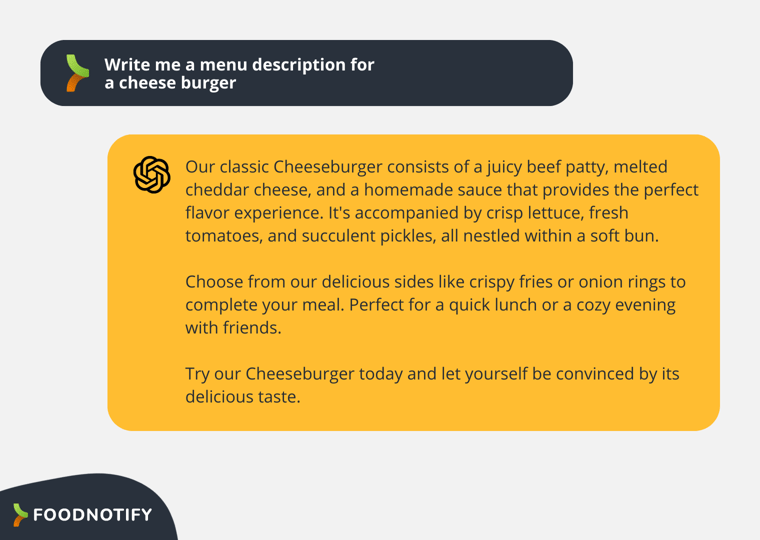
However, a menu description is only complete when it also includes a suitable image. While ChatGPT can't assist with that, there's another tool from OpenAI that works with artificial intelligence and can support you in this regard.
With DALL-E, images can be created from textual descriptions. As the tool generates images randomly, no result is the same as another. Users can also upload their own photos and have them modified by DALL-E.
Of course, it's always better to use photos that accurately represent the dish as guests will receive it in your restaurant. However, if you need images for your website, purely for decorative purposes, you can seek assistance from the tool and create unique photos for your online presence.
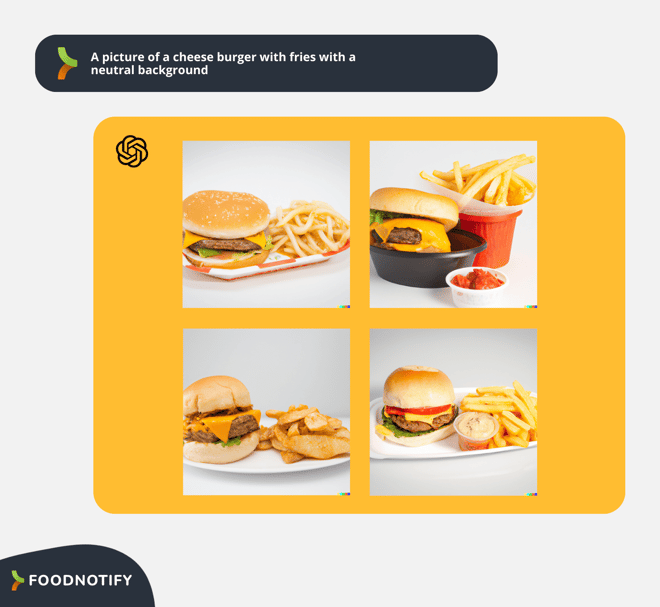
Another area in the hospitality industry where ChatGPT can assist you is your marketing. Whether it's for social media, your website, or your newsletter, the chatbot can help brainstorm content ideas and generate content.
You can also use the tool to send personalized messages to your guests and inform them about special offers or events. By targeting specific customers with relevant promotions, ChatGPT can assist you in marketing your business and increasing your revenue.
Here's an example of how a request to ChatGPT might sound like:
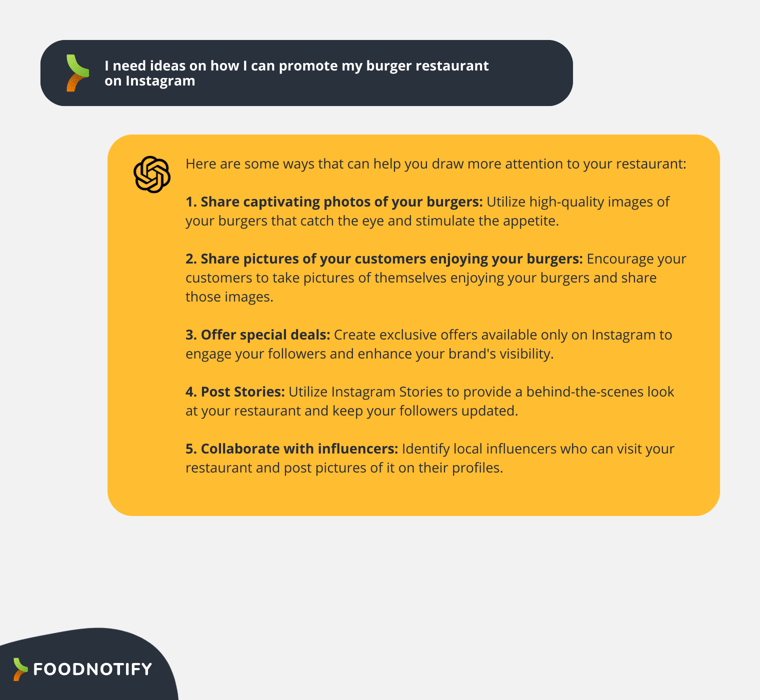
Onboarding new personnel can be time-consuming and resource-intensive. It's incredibly important, however, to conduct a thorough and structured onboarding process for new employees. This ensures they feel comfortable in your company and are successful in completing their tasks.
Here are some ideas on how ChatGPT can assist you in onboarding new employees:
Of course, the personal aspect of onboarding new employees should never be compromised. Nonetheless, the chatbot can serve as a support and significantly reduce the time and effort required for the onboarding process.
Here is an example of how ChatGPT could be used to depict a scenario in a restaurant for practicing communication skills:
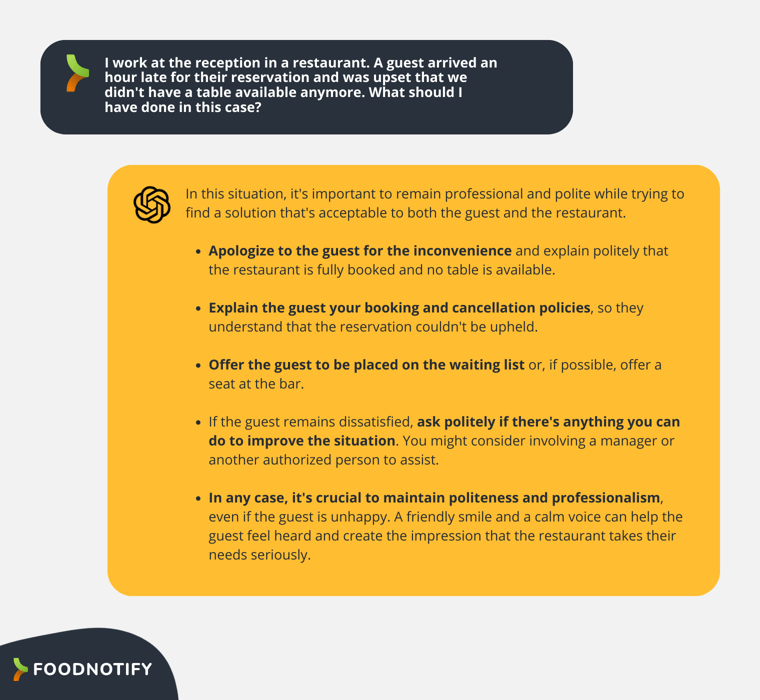
Now, I also want to show you the advancements that have already been made in this field.
Recently, it was announced that ChatGPT can now provide recommendations for restaurant visits. This is made possible through a partnership with OpenTable, a provider of online reservations for the restaurant industry.
Through a plugin, the chatbot can access the reservation tool's data, enabling it to generate responses to queries like: "I'm planning a birthday dinner for my sister next Friday for 15 people. Which restaurants in Manhattan should we consider?"
The recommendations also include a link to make a reservation. Currently, this feature is only available to subscribers of ChatGPT Plus in the USA and Canada.
Another use case of ChatGPT in the hospitality industry was adopted by a pizza restaurant in Dubai. The business, named Dodo Pizza, uses ChatGPT to create recipes for its pizzas.
According to the chef, the tool provided him with the opportunity to experiment with new ideas and incorporate Arabic flavors that he wouldn't have otherwise considered for his pizzas. As a result, he created unique combinations with novel tastes that have generated excitement among the guests.
ChatGPT is an impressive tool, and we can expect to see further developments in the future. In this regard, we're still at the beginning and will continue to learn how to make the most effective use of it.
In my opinion, the chatbot has the potential to change the way restaurant businesses operate. Restaurateurs gain support in various aspects and can focus on other tasks, such as providing on-site guest service.
As with any technological advancement, it ultimately depends on people how they harness it to their advantage and discover the best ways to use it. I'm excited to see the possibilities that ChatGPT will bring to the hospitality industry and look forward to it with optimism.
Find out how to manage change in restaurants by using digital tools, effective communication and team engagement to ensure success and transformation.
Discover how future-ready restaurants use connected tech stacks to cut costs, boost margins, and scale smarter.
Want to know how to reduce food waste in restaurants? Here are 5 tips you can use to avoid wasting food in your hospitality business.
Make sure you never miss out on updates and trends about digitalization in the hospitality industry by subscribing to our monthly newsletter. You will receive useful information delivered directly to your inbox.